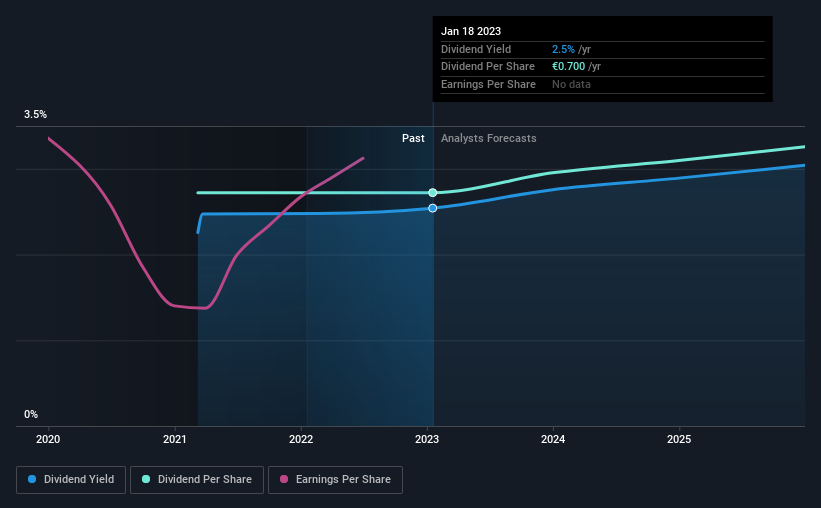Should You Buy JDE Peet's N.V. (AMS:JDEP) For Its Upcoming Dividend?
JDE Peet's N.V. (AMS:JDEP) is about to trade ex-dividend in the next 4 days. The ex-dividend date is one business day before a company's record date, which is the date on which the company determines which shareholders are entitled to receive a dividend. The ex-dividend date is of consequence because whenever a stock is bought or sold, the trade takes at least two business day to settle. Accordingly, JDE Peet's investors that purchase the stock on or after the 23rd of January will not receive the dividend, which will be paid on the 27th of January.
The company's next dividend payment will be €0.35 per share, and in the last 12 months, the company paid a total of €0.70 per share. Last year's total dividend payments show that JDE Peet's has a trailing yield of 2.5% on the current share price of €27.54. If you buy this business for its dividend, you should have an idea of whether JDE Peet's's dividend is reliable and sustainable. We need to see whether the dividend is covered by earnings and if it's growing.
View our latest analysis for JDE Peet's
Dividends are usually paid out of company profits, so if a company pays out more than it earned then its dividend is usually at greater risk of being cut. That's why it's good to see JDE Peet's paying out a modest 39% of its earnings. A useful secondary check can be to evaluate whether JDE Peet's generated enough free cash flow to afford its dividend. Luckily it paid out just 23% of its free cash flow last year.
It's positive to see that JDE Peet's's dividend is covered by both profits and cash flow, since this is generally a sign that the dividend is sustainable, and a lower payout ratio usually suggests a greater margin of safety before the dividend gets cut.
Click here to see the company's payout ratio, plus analyst estimates of its future dividends.
Have Earnings And Dividends Been Growing?
Businesses with strong growth prospects usually make the best dividend payers, because it's easier to grow dividends when earnings per share are improving. If earnings fall far enough, the company could be forced to cut its dividend. For that reason, it's encouraging to see JDE Peet's's earnings over the past year have risen 56%. While we'd be remiss not to point out that a year is a very short time in dividend investing, it's an encouraging sign so far. JDE Peet's is paying out less than half its earnings and cash flow, while simultaneously growing earnings per share at a rapid clip. Companies with growing earnings and low payout ratios are often the best long-term dividend stocks, as the company can both grow its earnings and increase the percentage of earnings that it pays out, essentially multiplying the dividend.
One year is not very long in the grand scheme of things though, so we wouldn't draw too strong a conclusion based on these results.
Another key way to measure a company's dividend prospects is by measuring its historical rate of dividend growth. JDE Peet's's dividend payments are broadly unchanged compared to where they were two years ago.
The Bottom Line
From a dividend perspective, should investors buy or avoid JDE Peet's? JDE Peet's has been growing earnings at a rapid rate, and has a conservatively low payout ratio, implying that it is reinvesting heavily in its business; a sterling combination. It's a promising combination that should mark this company worthy of closer attention.
With that in mind, a critical part of thorough stock research is being aware of any risks that stock currently faces. In terms of investment risks, we've identified 1 warning sign with JDE Peet's and understanding them should be part of your investment process.
Generally, we wouldn't recommend just buying the first dividend stock you see. Here's a curated list of interesting stocks that are strong dividend payers.
Have feedback on this article? Concerned about the content? Get in touch with us directly. Alternatively, email editorial-team (at) simplywallst.com.
This article by Simply Wall St is general in nature. We provide commentary based on historical data and analyst forecasts only using an unbiased methodology and our articles are not intended to be financial advice. It does not constitute a recommendation to buy or sell any stock, and does not take account of your objectives, or your financial situation. We aim to bring you long-term focused analysis driven by fundamental data. Note that our analysis may not factor in the latest price-sensitive company announcements or qualitative material. Simply Wall St has no position in any stocks mentioned.
Join A Paid User Research Session
You’ll receive a US$30 Amazon Gift card for 1 hour of your time while helping us build better investing tools for the individual investors like yourself. Sign up here

 Yahoo Finance
Yahoo Finance 
